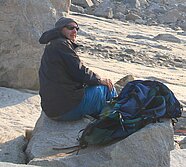Flash Flood Potential Mapping Using GIS and Flash Flood Potential Index (FFPI) in Turtle River and Forest River watersheds, North Dakota
Dasuni Ranapathi Arachchige is a Master of Science student in the Department of Geography at the University of North Dakota. She holds a Bachelor of Arts degree in Geography from the University of Peradeniya, Sri Lanka. Her research interest is focused on mapping the critical areas of flash flooding using physiographic parameters in GIS.
Email: dasuni.perera@my.und.edu
Phone: 701-777-4246
Fellow: Dasuni Ranapathi Arachchige
Advisor: Gregory S. Vandeberg, Ph.D., Associate Professor and Graduate Director, Department of Geography, University of North Dakota.
Degree Progress: M.S. Geography in progress. Expected May 2015
Flash Flood Potential Mapping Using GIS and Flash Flood Potential Index (FFPI) in Turtle River and Forest River watersheds, North Dakota
Flash flooding is one of the most disastrous weather related natural hazards causing extensive damages and death. As it occurs rapidly and within a very short period of time, proper flash flood risk assessments, predictions and warnings are extremely important to make community resilient to flash flooding.
Historically flash flood hazards have been addressed in many ways in the United States. The commonly used applications are based on hydrologic and meteorological data. Flash Flood Guidance (FFG) and Gridded Flash Flood Guidance (GFFG) are two examples that have been used to monitor and predict imminent flash flooding by National Weather Service (NWS). In this research, the focus is on physiographic parameters that can help to predict the occurrence and intensity of flash floods. Flash Flood Potential Index (FFPI), designed by Gregory Smith in 2003, looks at four physiographic parameters (slope, soil, land use, and vegetation) that influence hydrologic response and flash flood potential. Mainly, FFPI is going to be applied to the selected study area.
North Dakota ahs experiences severe flood events throughout the history including flash flooding. Turtle River and Forest River located in upper Red River Basin, are two watersheds, which have been subjected to significant flash flooding. Digital Elevation Models (DEM) are the primary elevation datasets in this study. The DEMs have resolutions of 30 meter and 3 meters (LiDAR based data set). Arc GIS is the primary tool that will be used to produce hydrologic models and the FFPI for these watersheds.
Project Objectives:
- Identify critical areas of the Turtle River and Forest watersheds of the upper Red River basin that have a high potential for flash flooding using FFPI
- Evaluate the sensitivity of this index to different resolutions of digital elevation models (e.g. 30m and 3 m) as well as ruggedness of landscape.
- Evaluate the effectiveness and applicability of the FFPI model compared with historical flash flood events that have occurred in the two watersheds using storm datasets.
- Conduct a standard hydrologic analysis of a subbasin of the study area and compare to FFPI
Significance:
Flash flooding is second to heat waves in weather related natural hazards causing extensive damages and deaths. These types of floods occur rapidly with significant impacts. Rapidly moving water, only a few centimeters deep, can lift people off their feet, and only a depth of a 0.3-0.6meters, is needed to sweep cars away. According to a 20 year National Weather Service Study ending in 2006, an average of 150 people per year perished due to hundreds of significant floods that occurred in the United States. Use of an effective and accurate potential assessment index will benefit emergency managers, planning boards, and other local officials and groups who are responsible for making communities more flash flood resilient.

Gregory S. Vandeberg
Geography
Office: O'Kelly Hall Room 161
221 Centennial Dr Stop 9020
Grand Forks, ND 58202-7088
Telephone: 701-777-4588
Email: gregory.vandeberg@UND.edu



